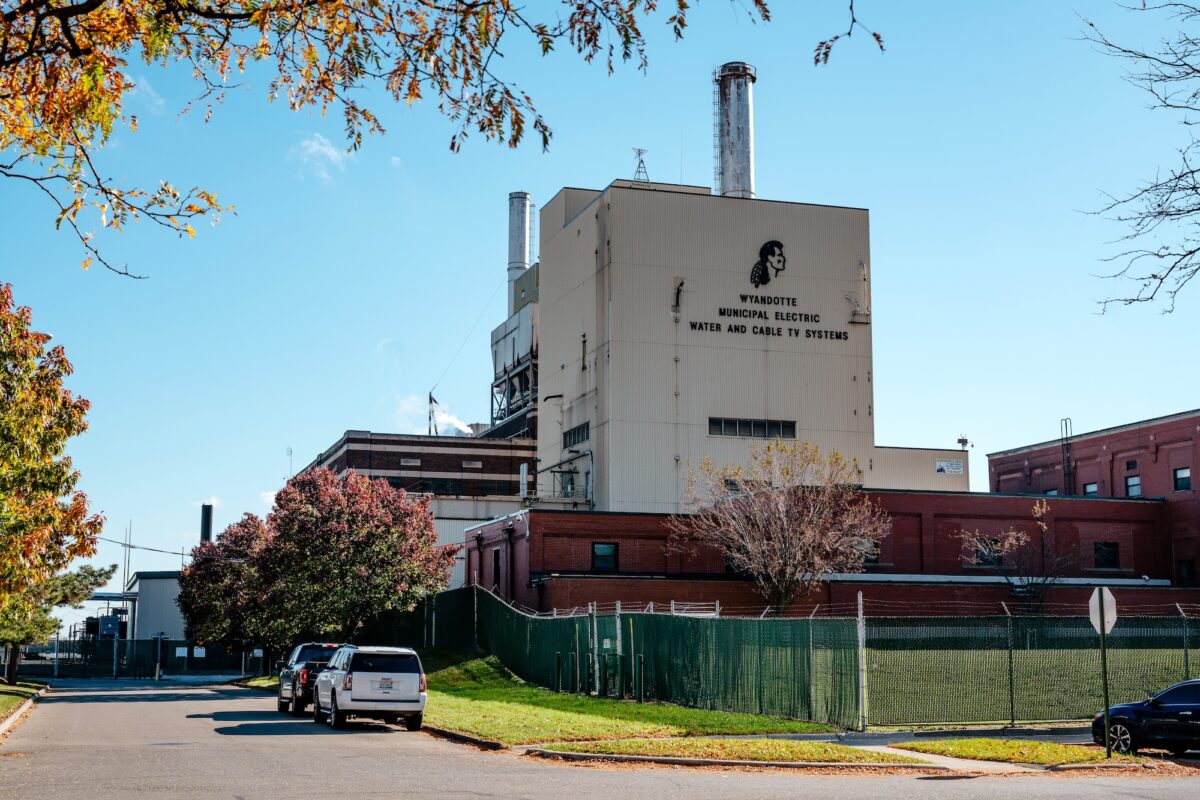Overview:
-Wyandotte fluoridated its water from 1951 until 2015.
-It's "imperative" for water providers to notify the public of interruptions in fluoridation so they can make informed oral health decisions, says an April 30 report on Wyandotte's drinking water system from Michigan's environmental regulator.
-"If residents had been aware of the lower levels of fluoridation, they could have taken steps to speak with health providers and looked into preventative measures," says Wyandotte resident Sarah Pettigrew.
Editor’s note: This story has been updated to reflect that Wyandotte Municipal Services deleted a statement about fluoridation of water from its website Tuesday afternoon after this story was published.
The news that Wyandotte appears to have largely suspended fluoridation of its drinking water supply over the last decade took Sarah Pettigrew by surprise.
Pettigrew, a Wyandotte resident, told Planet Detroit she realizes there is disagreement over water fluoridation, which helps prevent tooth decay, adding that transparency over the issue is fundamental for public health.
“If residents had been aware of the lower levels of fluoridation, they could have taken steps to speak with health providers and looked into preventative measures,” she said.
Planet Detroit reported last week that Wyandotte largely stopped fluoridating its water around 2015. The Wyandotte Municipal Services webpage said fluoride is added to water as part of the treatment process to prevent tooth decay until the page was updated Tuesday afternoon.
After this story was published, the phrase “add fluoride to prevent tooth decay” was deleted from a description of the city’s water treatment process, according to the Wayback Machine, an internet archive tool.
Disrepancies exist between a state survey and Wyandotte’s annual water reports as to when fluoride was discontinued.
According to the city’s 2010 annual water quality report, Wyandotte stepped down the level of fluoride in the water that year from 1.1 milligrams per liter to 0.7 milligrams per liter, in line with the U.S. Public Health Service’s recommendation for drinking water fluoridation. Wyandotte had fluoridated its water since 1951, the report said.
The city’s 2015-2018 water quality reports say fluoride was “shut off during [a] rehab project.” Reports in subsequent years show fluoride levels as “ND,” except for 2022, when it was detected at 0.04 milligrams per liter, below federal guidelines.
An April 30 report from the Michigan Department of Environment, Great Lakes, and Energy says fluoride has not been applied since 2017.
“If there is a prolonged interruption in fluoridation, it is imperative for the water supply to notify the public so residents can make informed decisions about their oral health,” the report states.
Wyandotte officials did not respond to Planet Detroit’s questions about the suspension of fluoridation in the city.
Fluoride: 1 of ’10 great public health interventions of the 20th century’
Research shows water fluoridation can cut cavities by roughly 25%, with the U.S. Centers for Disease Control and Prevention naming it one of the “10 great public health interventions of the 20th century.” Fluoride strengthens teeth and reduces cavities by replacing minerals lost during normal wear and tear, according to the CDC.
Fluoride can come from a number of sources, but drinking water is the main one for Americans, researchers say. Nearly two-thirds of the U.S. population receives fluoridated drinking water, according to CDC data.
People living in areas without fluoride in the water may need to be vigilant about their oral health and use special toothpaste or other treatments to ensure their teeth are protected.
Research shows there are problems when people drink more fluoride than the federal government’s recommended level of 0.7 milligrams per liter.
Excess fluoride intake is associated with streaking or spots on teeth. And studies have traced a link between excess fluoride and brain development.
A report last year by the federal government’s National Toxicology Program, which summarized studies conducted in Canada, China, Denmark, India, Iran, New Zealand, Pakistan, Mexico, Spain, and Taiwan, concluded that drinking water with more than 1.5 milligrams of fluoride per liter, more than twice the CDC’s recommended level, is associated with lower IQs in children.
U.S. Health Secretary Robert F. Kennedy Jr. said in April he planned to direct the CDC to stop recommending water fluoridation for communities. He’s called fluoride a “dangerous neurotoxin” and tied it to a range of health problems.
Excess fluoride has emerged as an issue in places like West Texas where source water contains large amounts of naturally occurring fluoride, according to the nonprofit magazine Undark reports.
Health authorities stress the safety of water fluoridation at appropriate levels.
“Seventy years of research, thousands of studies and the experience of more than 210 million Americans tell us that water fluoridation is effective in preventing cavities and is safe for children and adults,” the American Dental Association website says.
State and local governments oversee water fluoridation, so Kennedy has no direct control over whether they choose to add it.
Wyandotte water system problems pose ‘immediate health risk’: State regulator
State survey raises concerns about Wyandotte’s ability to protect water customers from BASF pollution and other contaminants, water expert says.
BASF Detroit River pollution: Environmental regulators discuss remedy for contaminated groundwater
Environmental advocates are calling for urgent action as regulators outline plans to curb pollution from BASF’s Wyandotte facility, which discharges 60 gallons of contaminated groundwater into the Detroit River every minute.
Michigan regulators request BASF’s plan to halt Detroit River pollution: Letter
Michigan regulators give BASF 60 days to produce a plan to stop contaminated groundwater from its Wyandotte chemical plant from polluting the Detroit River.
What to do if fluoride is removed from your water
Fluoride is a critical public health investment because it reaches everyone, Dr. Judith Jones, an adjunct professor of dentistry and public health at the University of Detroit Mercy, told Planet Detroit.
For every dollar invested in water fluoridation, communities save $20 in dental treatment costs, according to the CDC.
“When you cut fluoride in the water supply that decreases the city’s ability to control disease,” Jones said.
An increase in cavities could lead to more cases of tooth-related abscesses and facial cellulitis, Jones said. Facial cellulitis is an infection that can begin with untreated tooth decay and lead to brain infections, blocked airways, or the loss of eyes.
In places where water is no longer being fluoridated, Jones recommends parents have fluoride drops prescribed for their children. Older adults can use fluoride toothpaste and obtain a prescription for a high strength fluoride gel to apply after brushing.
She said people without fluoride in their water need to keep their teeth “spotlessly clean,” flossing and brushing for 2 minutes twice a day. Jones also advises people to visit their dentist twice a year and only eat sweets once a day.
One of the most important things residents of communities that have suspended fluoridation need to do is pressure decision-makers to put fluoride back in the water, Jones said.
“You’re looking at the cheapest, most effective way to prevent decay.”
Editor’s note: This story has been updated to name all countries included in data in a report last year by the federal government’s National Toxicology Program on fluoride and IQ in children.
The Associated Press contributed to this report.




